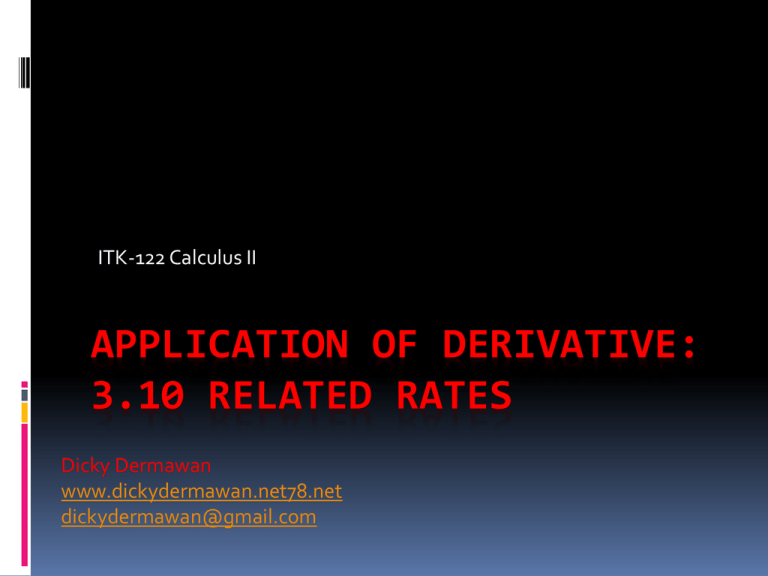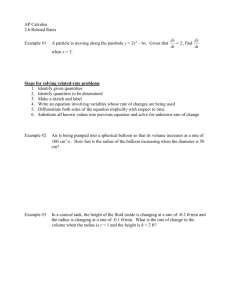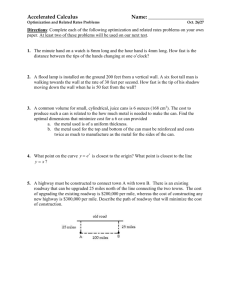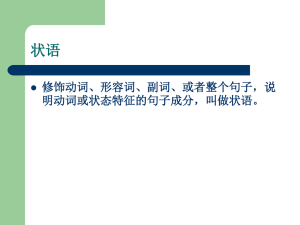5-3-10 Application of Differentiation-Related
advertisement

ITK-122 Calculus II APPLICATION OF DERIVATIVE: 3.10 RELATED RATES Dicky Dermawan www.dickydermawan.net78.net dickydermawan@gmail.com |||| 3.10 Related Rates Strategy It is useful to recall some of the problem-solving principles and adapt them to related rates 1. Read the problem carefully. 2. Draw a diagram if possible. 3. Introduce notation. Assign symbols to all quantities that are functions of time. 4. Express the given information and the required rate in terms of derivatives. 5. Write an equation that relates the various quantities of the problem. If necessary, use the geometry of the situation to eliminate one of the variables by substitution (as in Example 3). 6. Use the Chain Rule to differentiate both sides of the equation with respect to t 7. Substitute the given information into the resulting equation and solve for the unknown rate. |||| 3.10 Related Rates If we are pumping air into a balloon, both the volume and the radius of the balloon are increasing and their rates of increase are related to each other. But it is much easier to measure directly the rate of increase of the volume than the rate of increase of the radius. In a related rates problem the idea is to compute the rate of change of one quantity in terms of the rate of change of another quantity (which may be more easily measured). The procedure is to find an equation that relates the two quantities and then use the Chain Rule to differentiate both sides with respect to time. EXAMPLE 1 Air is being pumped into a spherical balloon so that its volume increases at a rate of 100 cm3/s. How fast is the radius of the balloon increasing when the diameter is 50 cm? |||| 3.10 Related Rates EXAMPLE 2 A ladder 10 ft long rests against a vertical wall. If the bottom of the ladder slides away from the wall at a rate of 1 ft/s, how fast is the top of the ladder sliding down the wall when the bottom of the ladder is 6 ft from the wall? EXAMPLE 3 A water tank has the shape of an inverted circular cone with base radius 2 m and height 4 m. If water is being pumped into the tank at a rate of 2 m3/min, find the rate at which the water level is rising when the water is 3 m deep. |||| 3.10 Related Rates EXAMPLE 4 Car A is traveling west at 50 mi/h and car B is traveling north at 60 mi/h. Both are headed for the intersection of the two roads. At what rate are the cars approaching each other when car A is 0.3 mi and car B is 0.4 mi from the intersection? EXAMPLE 5 A man walks along a straight path at a speed of 4 ft/s. A searchlight is located on the ground 20 ft from the path and is kept focused on the man. At what rate is the searchlight rotating when the man is 15 ft from the point on the path closest to the searchlight? Exercises Exercises 7–10 |||| (a) What quantities are given in the problem? (b) What is the unknown? (c) Draw a picture of the situation for any time t. (d) Write an equation that relates the quantities. (e) Finish solving the problem. 7. A plane flying horizontally at an altitude of 1 mi and a speed of 500 mi/h passes directly over a radar station. Find the rate at which the distance from the plane to the station is increasing when it is 2 mi away from the station. 8. If a snowball melts so that its surface area decreases at a rate of 1 cm2/min, find the rate at which the diameter decreases when the diameter is 10 cm. 9. A street light is mounted at the top of a 15-ft-tall pole. A man 6 ft tall walks away from the pole with a speed of 5 ft/s along a straight path. How fast is the tip of his shadow moving when he is 40 ft from the pole? 10. At noon, ship A is 150 km west of ship B. Ship A is sailing east at 35 km/h and ship B is sailing north at 25 kmh. How fast is the distance between the ships changing at 4:00 P.M.? Exercises 11. Two cars start moving from the same point. One travels south at 60 mi/h and the other travels west at 25 mi/h. At what rate is the distance between the cars increasing two hours later? 12. A spotlight on the ground shines on a wall 12 m away. If a man 2 m tall walks from the spotlight toward the building at a speed of 1.6 m/s, how fast is the length of his shadow on the building decreasing when he is 4 m from the building? 13. A man starts walking north at 4 ft/s from a point P. Five minutes later a woman starts walking south at 5 ft/s from a point 500 ft due east of P. At what rate are the people moving apart 15 min after the woman starts walking? Exercises 14. A baseball diamond is a square with side 90 ft. A batter hits the ball and runs toward first base with a speed of 24 ft/s. (a) At what rate is his distance from second base decreasing when he is halfway to first base? (b) At what rate is his distance from third base increasing at the same moment? Exercises 15.The altitude of a triangle is increasing at a rate of 1 cm/min while the area of the triangle is increasing at a rate of 2 cm2/min. At what rate is the base of the triangle changing when the altitude is 10 cm and the area is 100 cm2 ? 16.A boat is pulled into a dock by a rope attached to the bow of the boat and passing through a pulley on the dock that is 1 m higher than the bow of the boat. If the rope is pulled in at a rate of 1 m/s, how fast is the boat approaching the dock when it is 8 m from the dock? Exercises 17. At noon, ship A is 100 km west of ship B. Ship A is sailing south at 35 km/h and ship B is sailing north at 25 km/h. How fast is the distance between the ships changing at 4:00 P.M.? 18. A particle is moving along the curve y=√x. As the particle passes through the point (4,2) , its x-coordinate increases at a rate of 3 cm/s. How fast is the distance from the particle to the origin changing at this instant? 19. Water is leaking out of an inverted conical tank at a rate of 10,000 cm3/min at the same time that water is being pumped into the tank at a constant rate. The tank has height 6 m and the diameter at the top is 4 m. If the water level is rising at a rate of 20 cm/min when the height of the water is 2 m, find the rate at which water is being pumped into the tank. Exercises 17. Boyle’s Law states that when a sample of gas is compressed at a constant temperature, the pressure P and volume V satisfy the equation PV = C, where C is a constant. Suppose that at a certain instant the volume is 600 cm3 , the pressure is 150 kPa, and the pressure is increasing at a rate of 20 kPa/min. At what rate is the volume decreasing at this instant? 18. When air expands adiabatically (without gaining or losing heat), its pressure P and volume V are related by the equation PV1.4 = C, where C is a constant. Suppose that at a certain instant the volume is 400 cm and the pressure is 80 kPa and is decreasing at a rate of 10 kPa/min. At what rate is the volume increasing at this instant? Exercises Exercises 30. Brain weight as a function of body weight W in fish has been modeled by the power function B = 0.007 W2/3, where B and W are measured in grams. A model for body weightas a function of body length L (measured in centimeters) is W = 0.12 L2.53. If, over 10 million years, the average length of a certain species of fish evolved from 15 cm to 20 cm at a constant rate, how fast was this species’ brain growing when the average length was 18 cm?










